The Intel Haswell-E X99 Motherboard Roundup with ASUS, GIGABYTE, ASRock and MSI
by Ian Cutress on September 25, 2014 11:30 AM ESTCPU Benchmarks
Readers of our motherboard review section will have noted the trend in modern motherboards to implement a form of MultiCore Enhancement / Acceleration / Turbo (read our report here) on their motherboards. This does several things, including better benchmark results at stock settings (not entirely needed if overclocking is an end-user goal) at the expense of heat and temperature. It also gives in essence an automatic overclock which may be against what the user wants. Our testing methodology is ‘out-of-the-box’, with the latest public BIOS installed and XMP enabled, and thus subject to the whims of this feature. It is ultimately up to the motherboard manufacturer to take this risk – and manufacturers taking risks in the setup is something they do on every product (think C-state settings, USB priority, DPC Latency / monitoring priority, memory subtimings at JEDEC). Processor speed change is part of that risk, and ultimately if no overclocking is planned, some motherboards will affect how fast that shiny new processor goes and can be an important factor in the system build.
For our tests today, it would seem that all the motherboards had some form of MultiCore Turbo, although because we are testing with a JEDEC memory kit, some are more ‘turned on’ than others. The GIGABYTE and ASUS motherboards seemed more content at stock and mid-turbo frequencies, whereas the MSI and ASRock were more aggressive.
Point Calculations – 3D Movement Algorithm Test: link
3DPM is a self-penned benchmark, taking basic 3D movement algorithms used in Brownian Motion simulations and testing them for speed. High floating point performance, MHz and IPC wins in the single thread version, whereas the multithread version has to handle the threads and loves more cores.
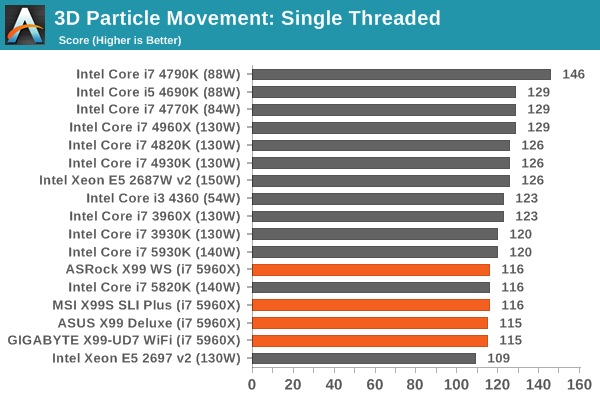
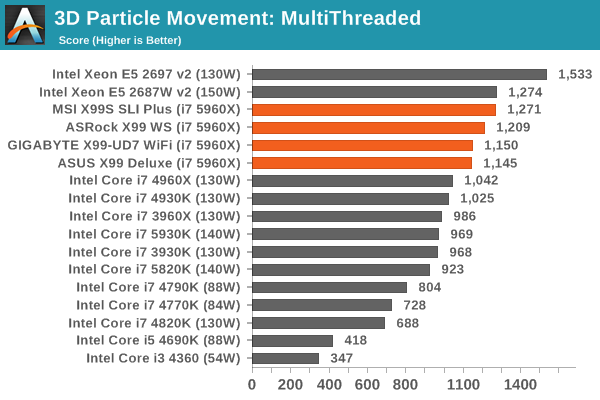
The MSI takes a commanding lead in the multi-threaded version of the test.
Compression – WinRAR 5.0.1: link
Our WinRAR test from 2013 is updated to the latest version of WinRAR at the start of 2014. We compress a set of 2867 files across 320 folders totaling 1.52 GB in size – 95% of these files are small typical website files, and the rest (90% of the size) are small 30 second 720p videos.
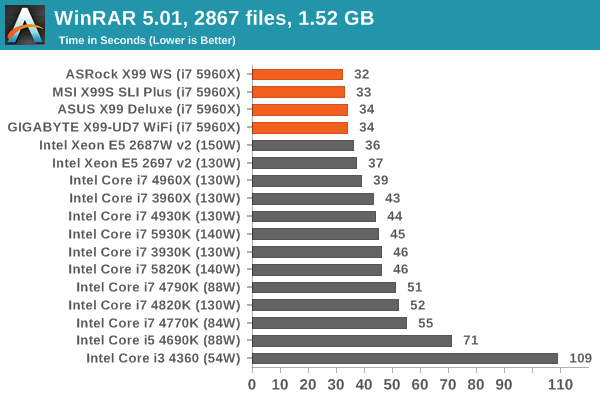
In comparison, the ASRock wins here.
Image Manipulation – FastStone Image Viewer 4.9: link
Similarly to WinRAR, the FastStone test us updated for 2014 to the latest version. FastStone is the program I use to perform quick or bulk actions on images, such as resizing, adjusting for color and cropping. In our test we take a series of 170 images in various sizes and formats and convert them all into 640x480 .gif files, maintaining the aspect ratio. FastStone does not use multithreading for this test, and thus single threaded performance is often the winner.
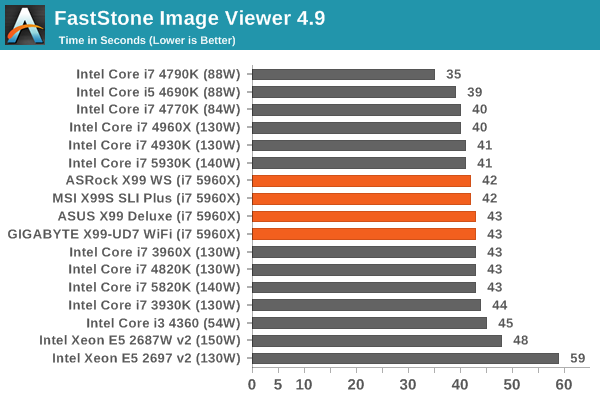
The split between MSI/ASRock against ASUS/GIGABYTE results in a one second gap in our FastStone test.
Video Conversion – Handbrake v0.9.9: link
Handbrake is a media conversion tool that was initially designed to help DVD ISOs and Video CDs into more common video formats. The principle today is still the same, primarily as an output for H.264 + AAC/MP3 audio within an MKV container. In our test we use the same videos as in the Xilisoft test, and results are given in frames per second.
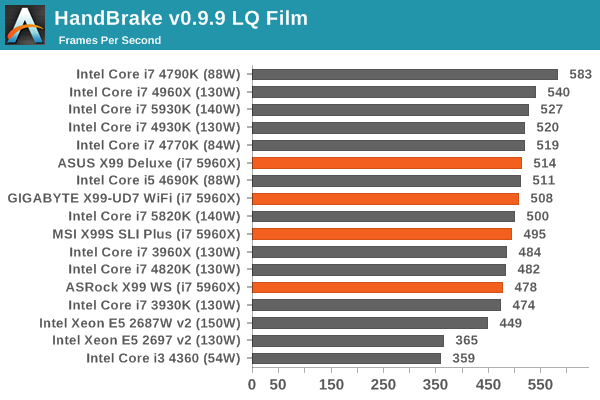

Interestingly here the ASUS and GIGABYTE pull ahead during the low quality test, but at 4K the ASRock scores the points.
Rendering – PovRay 3.7: link
The Persistence of Vision RayTracer, or PovRay, is a freeware package for as the name suggests, ray tracing. It is a pure renderer, rather than modeling software, but the latest beta version contains a handy benchmark for stressing all processing threads on a platform. We have been using this test in motherboard reviews to test memory stability at various CPU speeds to good effect – if it passes the test, the IMC in the CPU is stable for a given CPU speed. As a CPU test, it runs for approximately 2-3 minutes on high end platforms.
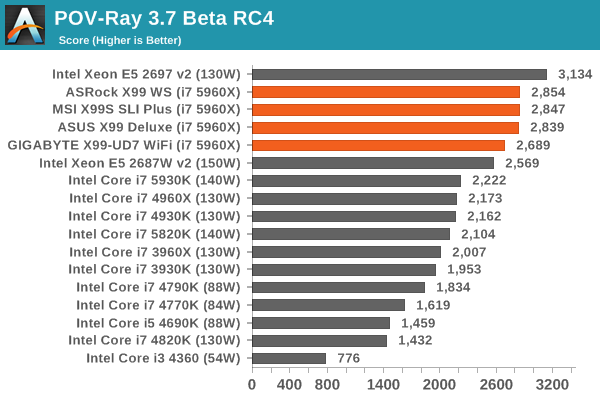
MultiCore Turbo affects motherboards more in tests such as POV-Ray, and the GIGABYTE drops down here.
Synthetic – 7-Zip 9.2: link
As an open source compression tool, 7-Zip is a popular tool for making sets of files easier to handle and transfer. The software offers up its own benchmark, to which we report the result.
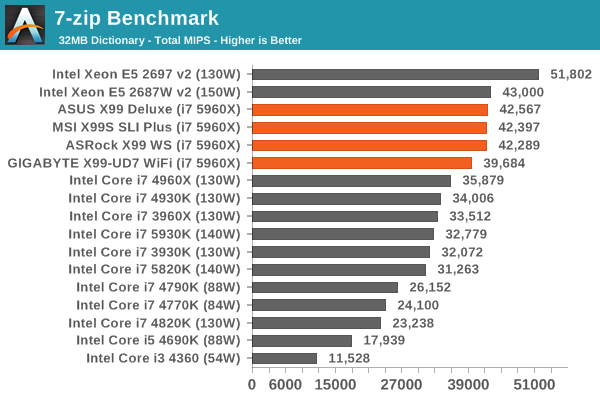










62 Comments
View All Comments
Ian Cutress - Friday, September 26, 2014 - link
Usually some of the 16xx series have some leeway, but the larger 26xx are definitely locked down. I've managed 107 MHz BCLK from an E5 2697 v3, but YMMV.halcyon - Thursday, September 25, 2014 - link
Is this correct:http://i.imgur.com/3AgxLfs.png
bebimbap - Thursday, September 25, 2014 - link
That's probably because the 5960x runs at 3.0-3.5ghz stock while the 4790k runs 4.0-4.4ghz stockso if it is single threaded MHz limited, then the 4790k can run 14%-47% faster than the 5960x can at stock settings.
Ian Cutress - Friday, September 26, 2014 - link
Minimum frame rate results are always tricky. If the system software initiates something critical in the foreground and causes a single frame to falter, then the whole minimum frame rate is reduced. That's why I'm not always too keen on reporting them, but have them included for completeness.The single thread speed is also another aspect, also depending on the cache orientation of the CPU, it might cause a frame or two to load faster/slower than others, again causing that one frame drop.
Given that this is more common across the Haswell-E line, compared to Haswell, it might be something that fundamental.
bebimbap - Thursday, September 25, 2014 - link
I had always thought MSI was a top tier vendor of MB and GPU's but after my gtx 8800 "malfunctioned," back when they were the best available, and then my z87 mpower MSI MB headers fall apart, and OC's at higher voltages compared to my z87 gigabyte ud5h and is hotter at the same voltages. It made me think about it, and MSI is very similar in marketing style as XFX. They are both usually heavy on rebates, and very cheap for the amount of product you get. But they lack quality. None of my XFX cards perform as well as their Asus/EVGA/Gigabyte counterparts. I now put them in the same tier as ECS and Biostar.The MSI board OC'd performance being less seemed more of the same, and I was expecting as much. Until something drastically changes, I'll only use Asus/Gigabyte/Asrock.
just4U - Thursday, September 25, 2014 - link
That's unfortunate.. however you do have to keep in mind that these are sensitive electronic components. I've had boards fail by all the major companies. It happens.. I had 3 dead boards in the Genie Rog Asus series all out of the first batch that came in (7 in total) did it stop me from using Asus? No.. again it happens. Had loose heatsinks dead chipset fans, a capacitor that fell off.. ugh.. Still if I dropped all the companies where that had happened I'd not have any companies to turn to lol.Msi is doing a lot of good things these days and their easily right up there with Gigabyte and Asus.
CFTheDragon - Thursday, September 25, 2014 - link
Why is there not the MSI X99 Gaming in the review? Is anyone really going to buy the normal version and not the Gaming one for a X99 build?Ian Cutress - Friday, September 26, 2014 - link
For review time, these are the samples we were sourced. Not every model is available for review, depending on how the manufacturer wants to focus on different titles. We asked MSI what their most popular/consumer focused board would be in terms of numbers, and they seem really pleased internally with the SLI Plus.The_Assimilator - Friday, September 26, 2014 - link
The only people who buy "Gaming" boards are the gullible who like bling and think that the KillerNIC is something desirable to have, rather than the liability it actually is.Flunk - Friday, September 26, 2014 - link
Unless the "Gaming" board happens to be cheaper, which happens a lot because I don't think they sell that great. Damn Killer NICs, just give me Intel and be done with it. Killer started off as nothing but marketing and since they've were bought out by Qualcomm they're just remarked Qualcomm parts with tweaked drivers. MSI's "Gaming" line is a really cynical take on the whole affair, it's just their regular boards with red highlights and (only on some models) a few small IC changes.